Leiden, UB, VLF 48
A richly annotated manuscript of Martianus’ De nuptiis1
In this ninth-century manuscript made in Northeastern France, we find Martianus Capella’s De nuptiis Philologiae et Mercurii (On the Marriage of Philology and Mercury). Around the text of Martianus, a large commentary has been copied in several hands. The scribes who wrote the commentary use all kinds of high-end scribal techniques, such as Tironian notes (an ancient and medieval type of shorthand script), diagrams, reference signs and musical notation. It is a very good example of a scribal culture of the region of Auxerre, Rheims and Fleury in that period: a culture in which ancient and late ancient authors were studied with zeal, connected to one another and contrasted with each other.
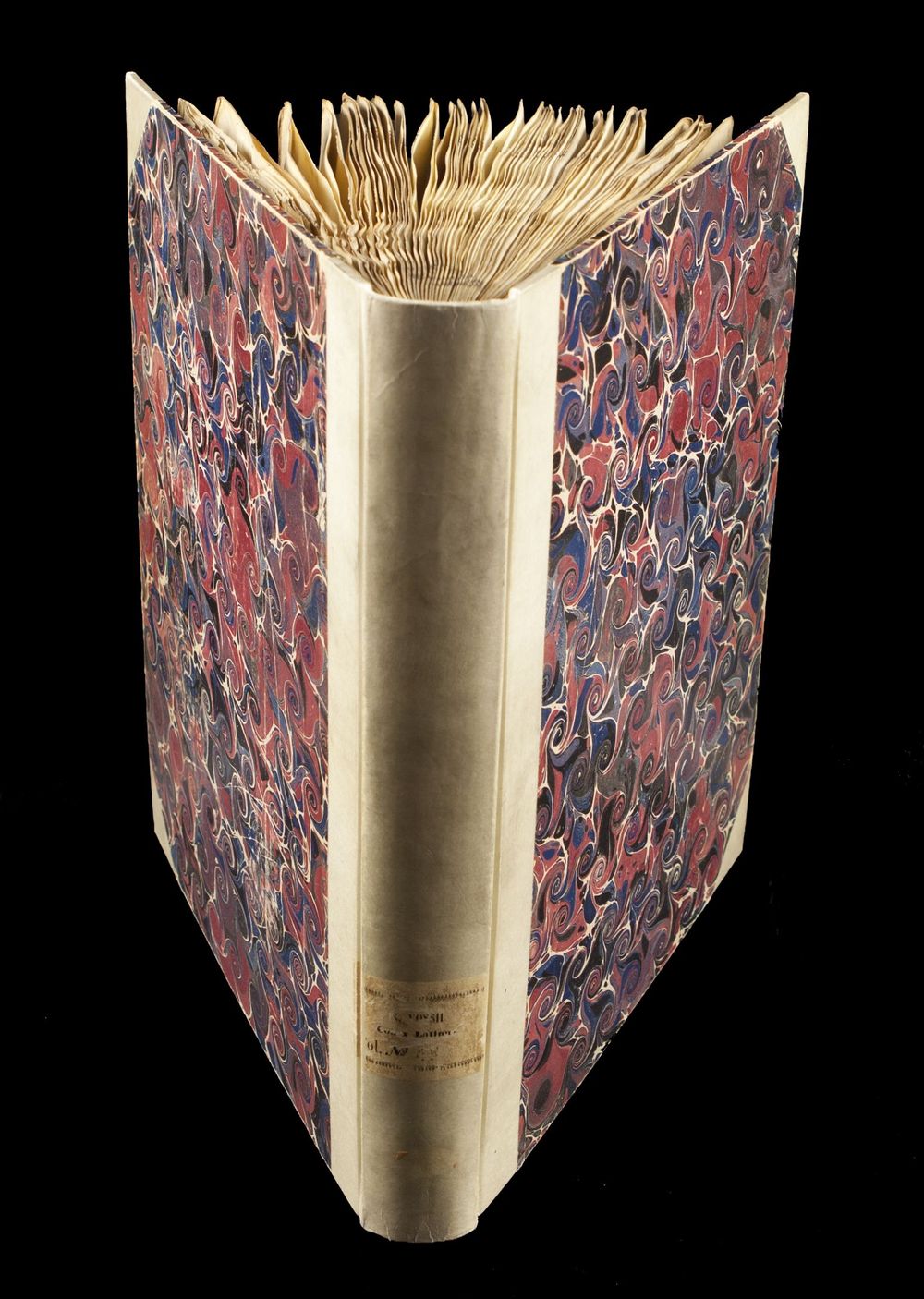
http://hdl.handle.net/1887.1/item:1618282
From the first page of the text on (fol. 2r), it is striking how densely annotated it is: a large column has been created on both sides of the text to accommodate commentary and glosses, and in between the lines of the main text, much of the available space has been used for glosses too. Even around this space allocated for commentary, however, more notes have been added in the inner and outer margins, at the top and at the bottom of the page. Note also, in the bottom margin, the old stamp of the University of Leiden (Academia Lugdunensis), and the piece of paper stating that this book was ‘from the libary of the illuster Isaac Vossius’, and once had the number 64.


The book was probably written in Auxerre. We think this because of how the letters are shaped. What we know of learned culture in Auxerre also fits the profile of this manuscript. Further evidence is this note in the margins of f. 50v, smack in the middle of the manuscript, from the bottom up and then into the upper margin: “HUNC LIBRUM DEDIT HELISEUS ARCHIDIACONUS SANCTO GERMANO PRO VITA ETERNA” (“Archdeacon Heliseus gave this book to Saint Germain for eternal life”).
The archdeacon Heliseus can be identified as a Heliseus from St. Stephen’s cathedral in Auxerre. We have his name as one of the signatories to a decree at the council at Douzy in 871. Saint Germain is the abbey of Saint Germain in Auxerre.
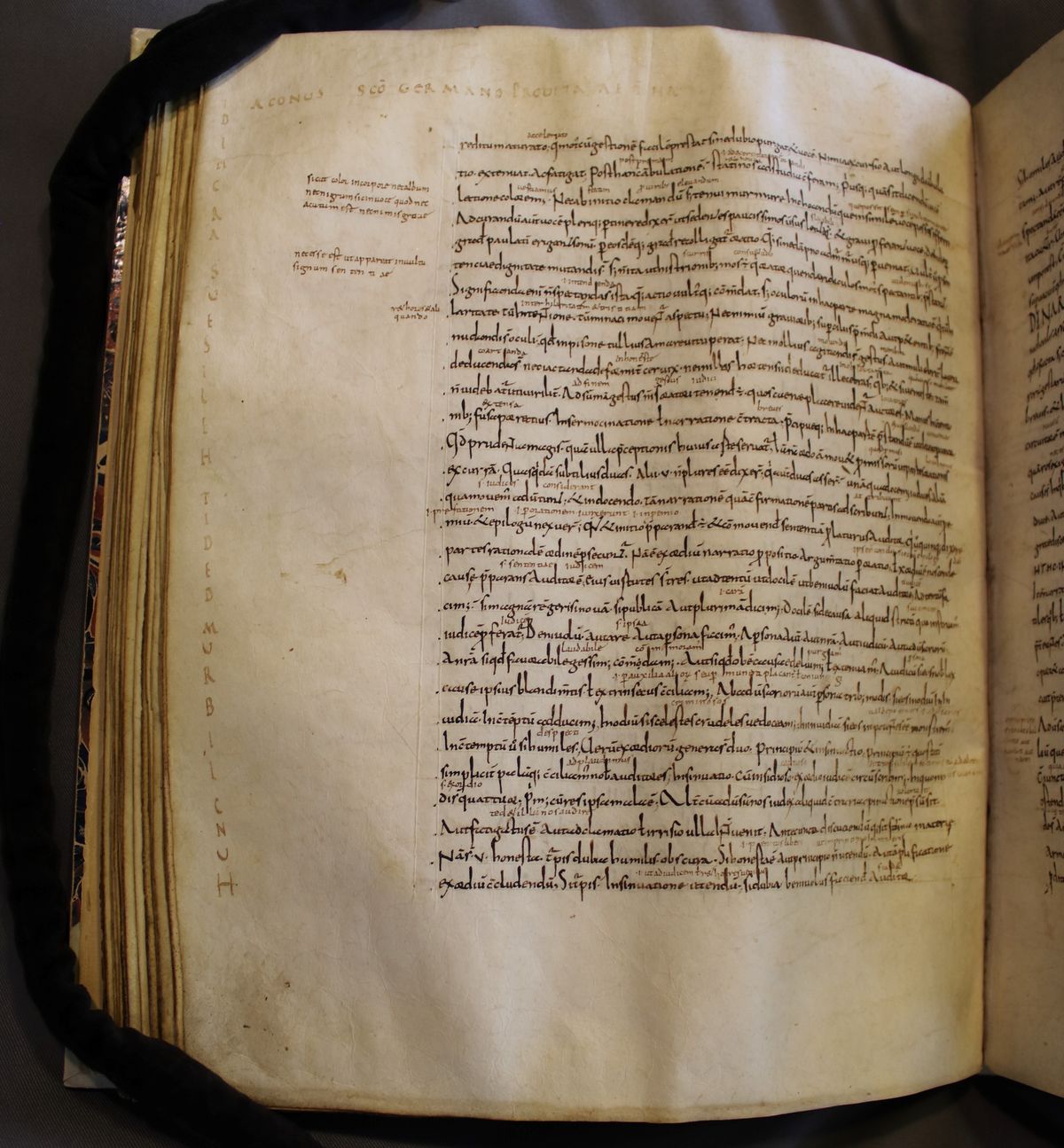

Let us zoom in on the upper half of the opening page (fol. 2r) to learn more about the components of the added texts in the margins. The long text marked by the red box (the boxes are added by us) is an introduction to the author and his work, a so-called accessus. It tells us who the author is, where he was born, what his work is about, and why he has written it. In the green box we can see in capital letters the title of the work: “From Martianus Mineus Felix Capella from Carthago, Africa, On the marriage of Philology.” A marginal note continues: “TWO BOOKS (that is: the first two books of De nuptiis that tell the story of the marriage). ON THE ART OF GRAMMAR: 1 (book), (a sign references to the continuation of this gloss above:) ON DIALECTIC 1 (book), ON RHETORIC 1 (book), ON GEOMETRY 1 (book), ON ARITHMETIC 1 (book), ON ASTRONOMY 1(book), ON MUSIC 1 (book).”
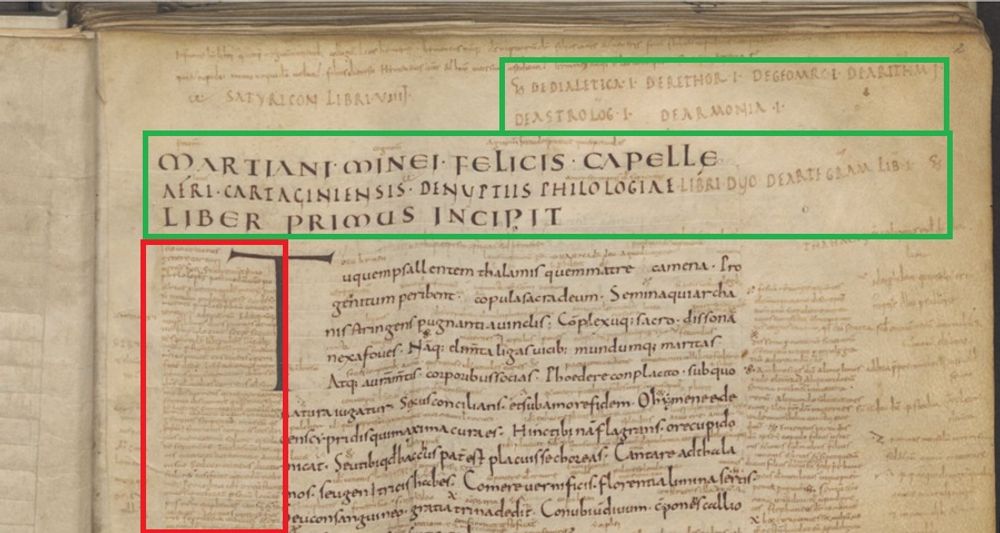
http://hdl.handle.net/1887.1/item:1618282
The commentary has been written in several hands. Some of them were written at approximately the same time as the main text. They were part of the original design of the book: always meant to be included. Others are additions from later readers. Here we see the three contemporary hands on the opening page: hand 1 (green boxes) and hand 2 (blue boxes), distinguished mainly by the colour of their ink, wrote in the area originally prepared for commentary. Hand 3 (red boxes) wrote extra notes in the space still available at the edges of the page.
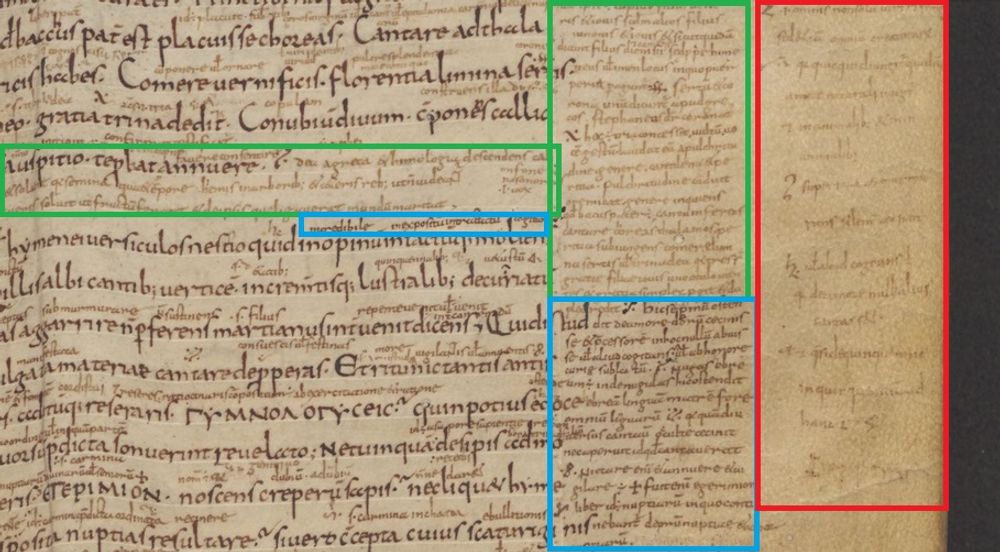
http://hdl.handle.net/1887.1/item:1618282
At the end of this gloss (green box), we see signs that are not letters, but Tironian notes, used by one of the contemporary scribes to make the text fit in the limited space he had. Tironian notes, so-called after their supposed inventor, Cicero’s slave and right hand Tiro, are a shorthand alphabet. In the early middle ages the Tironian notes were used for writing at dictation speed, writing in tight spots or for more personal, unfinished drafts. They are a sign of professional craftsmanship of a scribe at the highest level. This note on fol. 4v reads: “etiam dicitur. apo toy clitos quia ipse est advocatus nominum”.2
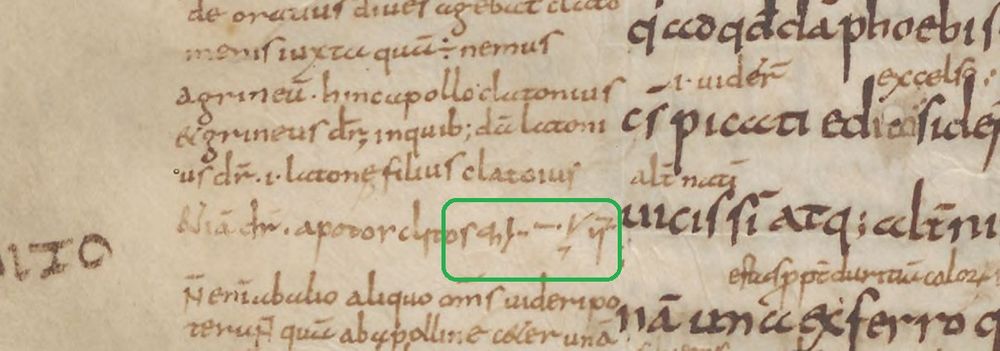
http://hdl.handle.net/1887.1/item:1618282
Once spotted, the Tironian notes are everywhere! In between the lines on f. 2v, for example, they are quite frequent.

http://hdl.handle.net/1887.1/item:1618282
On many pages we also spot the hand of a fourth, later scribe adding notes in the margin. Here is an example found on fol. 4v. It is the hand of Ratherius of Verona, a monk, bishop and scholar (887/890 – 974 AD). He picked up extraordinary words from the text of Martianus, and repeated them in the margin, presumably to add them to his own, notoriously rich vocabulary.3
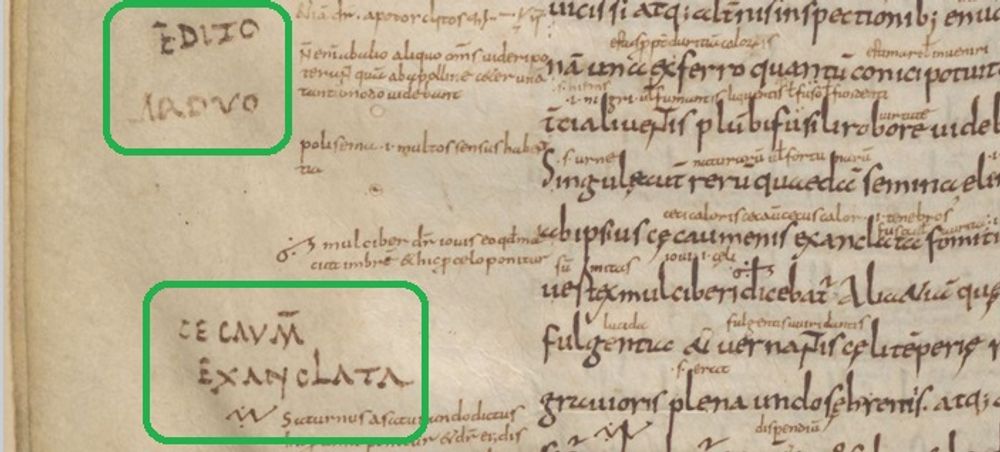

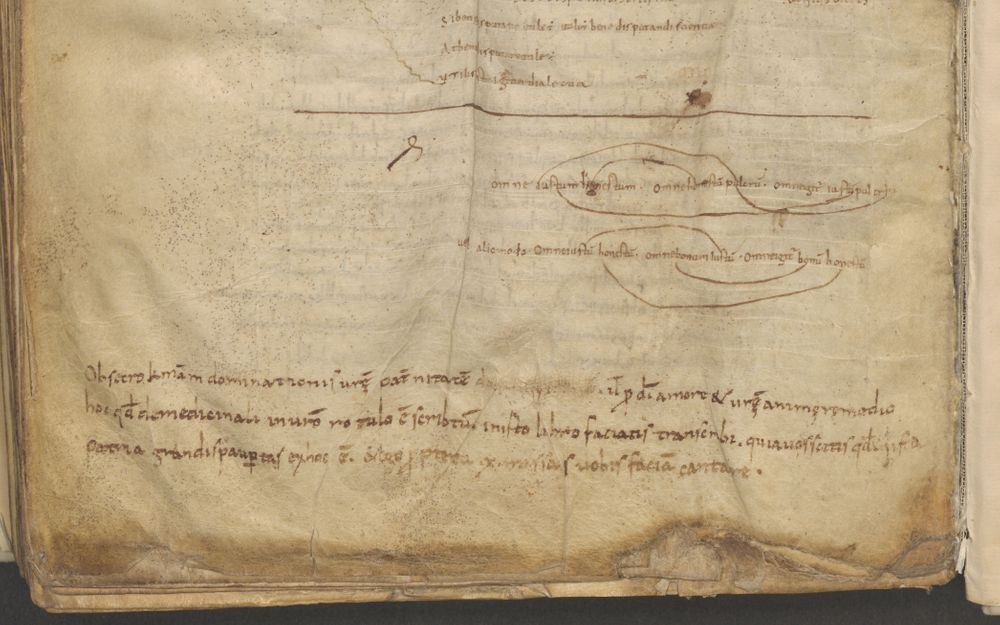

http://hdl.handle.net/1887.1/item:1618282
http://hdl.handle.net/1887.1/item:1618282
Turning to the pages where book IV, De dialectica starts, it is remarkable how densely filled the margins are with notes. This was a particularly well-studied part of the book!


In the book on dialectic, schemes or figures start to appear in which text was simplified into figure, perhaps in order to make it easier to understand or to imprint it upon the memory. Here we find a figure explaining how a being of one category differs from that in another because they do not share a certain quality: HOMO (= man) in the centre, differs from LAPIS (= stone) on the top, because it does not share the quality of animalitas (living); it differs from EQUUS (= horse), because it does not share the quality of ratio (the ability to think); it differs from ARBOR (= tree), because it does not share the quality of sensus (feeling); it differs from ANGELUS (= angel), because it does not share the quality of mortalitas (the ability to die). This whole explanation is compacted into one figure of barely one inch in diameter!


These figures or diagrams are a good source to see the dynamics of texts in the world of manuscripts: they travel from one context to another or are sometimes copied separately as aids to reading and understanding. On the last leaves of this manuscript, for example, a set of planetary diagrams, illustrating the way in which the planets travel around the earth in the cosmos, is copied (fol. 92v, detail). The diagram presents Martianus’s explanation of how the planets revolve, but also the explanations of others, notably Bede and Pliny. It is found in other manuscripts as well.4


In fact, the collecting of different authorities on certain topics is one of the main aims of the commentary. In many places it can be seen how other names are referenced to get to more, better or contrasting information. These references range from relatively specific (Augustine in his De doctrina christiana, or Pliny in his Naturalis historia) to very vague: “alii” (others), “philosophi” (philosophers). It is then up to us to find the sources of these pieces of information!
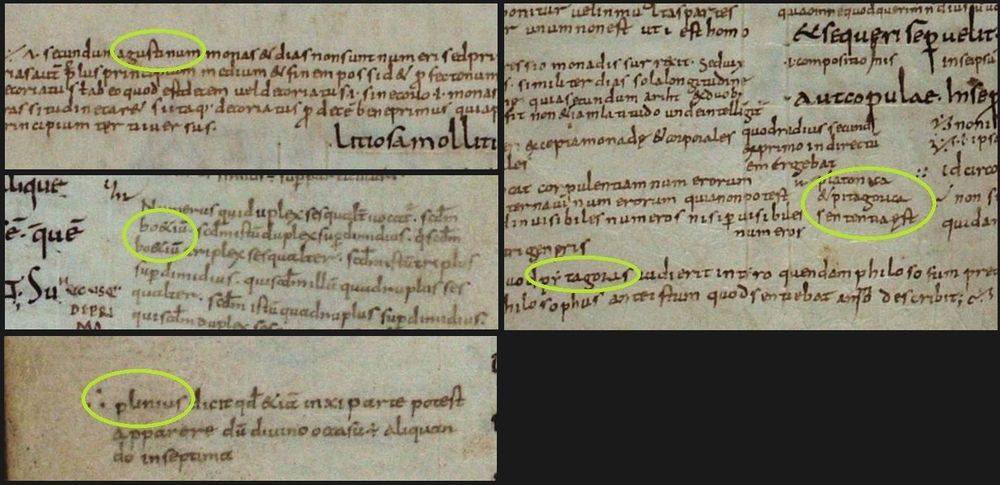
http://hdl.handle.net/1887.1/item:1618282
Sources used for this contribution:
- Description and bibliography on the Digital Special Collections website of Leiden University Library: http://hdl.handle.net/1887.1/item:1618282
- K.A. de Meyier, “Voss.Lat.F. 48 – Martianus Capella, varia”, in Codices Vossiani Latini, Pars I: Codices in folio, Leiden, 1973, 100-103
- Mariken Teeuwen, Harmony and the Music of the Spheres. The ars musica in ninth-century commentaries on Martianus Capella, (Mittellateinische Studien und Texte, 30), Leiden, Boston, Köln: Brill, 2002, 88-98
- Sinead O’Sullivan, Glossae Aevi Carolini in Libros I-II Martiani Capellae De nuptiis Philologiae et Mercurii (Corpus Christianorum Continuatio Mediaevalis, 237), Turnhout: Brepols, 2010
- Claudio Leonardi, “Raterio e Marziano Capella”, in: Italia Medioevale e Umanistica 2 (1959), 73-102
- Bruce S. Eastwood, Ordering the Heavens. Roman Astronomy and Cosmology in the Carolingian Renaissance (Medieval and Early Modern Philosophy and Science, 8), Leiden: Brill, 2007
Contribution by Mariken Teeuwen.
Cite as, Mariken Teeuwen, “Leiden, UB, VLF 48 ”, The art of reasoning in medieval manuscripts (Dec 2020), https://art-of-reasoning.huygens.knaw.nl/vlf48. ↑
O’Sullivan, Glossae Aevi Carolini, p. 82 ↑
Leonardi, Raterio e Marziano Capella ↑
Eastwood, Ordering the Heavens, 373-425 ↑


